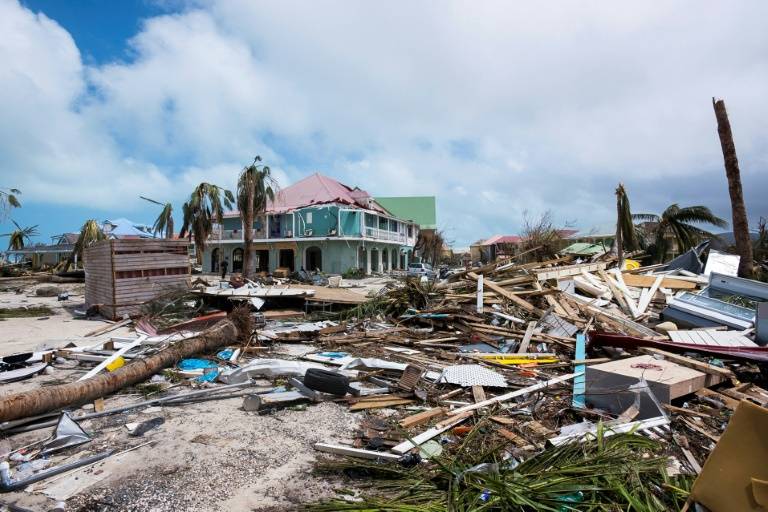MIAMI - Hurricane Irma pummelled the north coast of Cuba Saturday, inflicting "significant damage" as millions of people in the US state of Florida hunkered down for a direct hit from the monster storm.
Irma's blast through the Cuban coastline weakened the storm to a Category Three, but it is still packing 125 mile-an-hour winds (205 kilometre per hour) and was expected to regain power before hitting the Florida Keys early Sunday, US forecasters said.
At least 25 people have been killed since Irma began its devastating march through the Caribbean as a Category Five storm of nearly unmatched power, making landfall late Friday in Cuba on the Camaguey archipelago.
The Cuban government extended its maximum state of alert to three additional provinces, including Havana, amid fears of flooding in low-lying areas.
In Florida, cities on both the east and west coasts of the peninsular state took on the appearance of ghost towns, as nervous residents heeded insistent evacuation orders affecting 6.3 million people, nearly a third of the state's population.
The storm's forecast track has shifted slightly, so it now looks bound for Florida's west Gulf coast instead of the Atlantic coast, with landfall expected Sunday morning in the Florida Keys.
But Irma is so wide that authorities were bracing for destructive storm surges on both coasts and the Keys, the chain of low-lying islands that stretch south of Miami toward Cuba. And hurricane-force winds are expected to lash the peninsula as it rolls north toward Georgia.
Terrified Cubans who rode out Irma in coastal towns reported "deafening" winds, uprooted trees and power lines, and blown rooftops.
In the seaside town of Caibarien, the storm knocked down walls and littered the streets with tree branches, roof tiles and other debris.
Francis, a 19-year-old who lives near the Caibarien sea wall, said she fled to her grandfather's house as storm waters reached her street corner.
"It must be full of water," she said of her house. "What's out there is terrible," said Gisela Fernandez, a 42-year-old nurse.
After the storm whipped the town in Chapara in the province of Las Tunas Friday, Gisela Fernandez described a fearful ordeal. "The rain is finishing, but all night long there were terrible winds."
The governor of Camaguey province, Isabel Gonzalez Cardenas, said her area was "seriously affected," but there were no immediate reports of casualties. Cuban officials reported "significant damage."
More than a million people evacuated from vulnerable areas in Cuba.
In Key West, police opened a "shelter of last resort" for those fool-hardy enough to ignore mandatory evacuation orders.
Flood-prone Miami Beach, also under mandatory evacuation order, has been emptied of people but is bracing for high waters.
Scott Abraham, who lives on the fifth floor of a beachfront apartment building, is planning to ride the storm out with his wife and two kids. "If I lived in a house I would have left, but if it gets flooded here it's going to take a week at least to come back. I don't want that," he said.
In Miami, a big worry was the two dozen or so giant construction cranes in the downtown area. Though designed to withstand hurricane winds, city officials are warning people to stay away from them.
Across the peninsula the Gulf coast city of Fort Myers also was battening down for Irma's screaming winds, rain and storm surge.
"This is a worst case scenario for our city. And our region," the city's mayor, Randall Henderson said on CNN. "We're taking it very seriously. We are prepared for it."
Warning that Irma would be worse than Hurricane Andrew - which killed 65 people in 1992 - Florida's governor said all 20.6 million Floridians should prepare to flee.
Bumper-to-bumper traffic snaked north out of the state, with mattresses, gas cans and kayaks strapped to car roofs.
Cuban-American Orlando Reyes, 82, was forced to flee his assisted living facility in Miami Beach. "It is frightening," he told AFP at a shelter in Miami. "We had to leave without a cent, without taking a bath, or bringing anything."
The storm smashed through a string of Caribbean islands, beginning with tiny Barbuda on Wednesday, followed by the holiday islands of St Barts and St Martin.
Also affected were the US Virgin Islands, Puerto Rico, the Dominican Republic, Haiti and the Turks and Caicos. The Bahamas were spared Irma's worst.
French state-owned reinsurer CCR estimated Irma had caused 1.2 billion euros ($1.4 billion) worth of damage to homes, vehicles and businesses in the territories of Saint Martin and Saint Barts.
"Houses are smashed, the airport is out of action," St Barts resident Olivier Toussaint told AFP. "Upside-down cars are in the cemeteries. Boats are sunk in the marina, shops are destroyed."
Meteorologists meanwhile were closely monitoring two other Atlantic storms.
Jose, another powerful Category 4 storm, was heading towards the same string of Caribbean islands Irma has pummeled in recent days.
The deteriorating weather grounded aircraft and prevented boats from bringing relief supplies to hard-hit islands.
Katia, which made landfall in eastern Mexico late Friday as a Category One hurricane, had weakened by Saturday to a tropical depression. Mexico reported two people killed by mudslides unleashed by the heavy rains.
The US military was mobilizing thousands of troops and deploying several large ships to aid with evacuations and humanitarian relief, as the Air Force removed scores of planes from the southern United States.
Meanwhile, the death toll from across the islands has continued to rise.
Six were reported killed in the British Virgin Islands and Anguilla, including an elderly man who was crushed when his house collapsed. Two were killed in Puerto Rico, and four more in the US Virgin Islands.
A child died in Barbuda, at least 10 in France's Caribbean territories, and two more on the Dutch side of St Martin.
AFP






